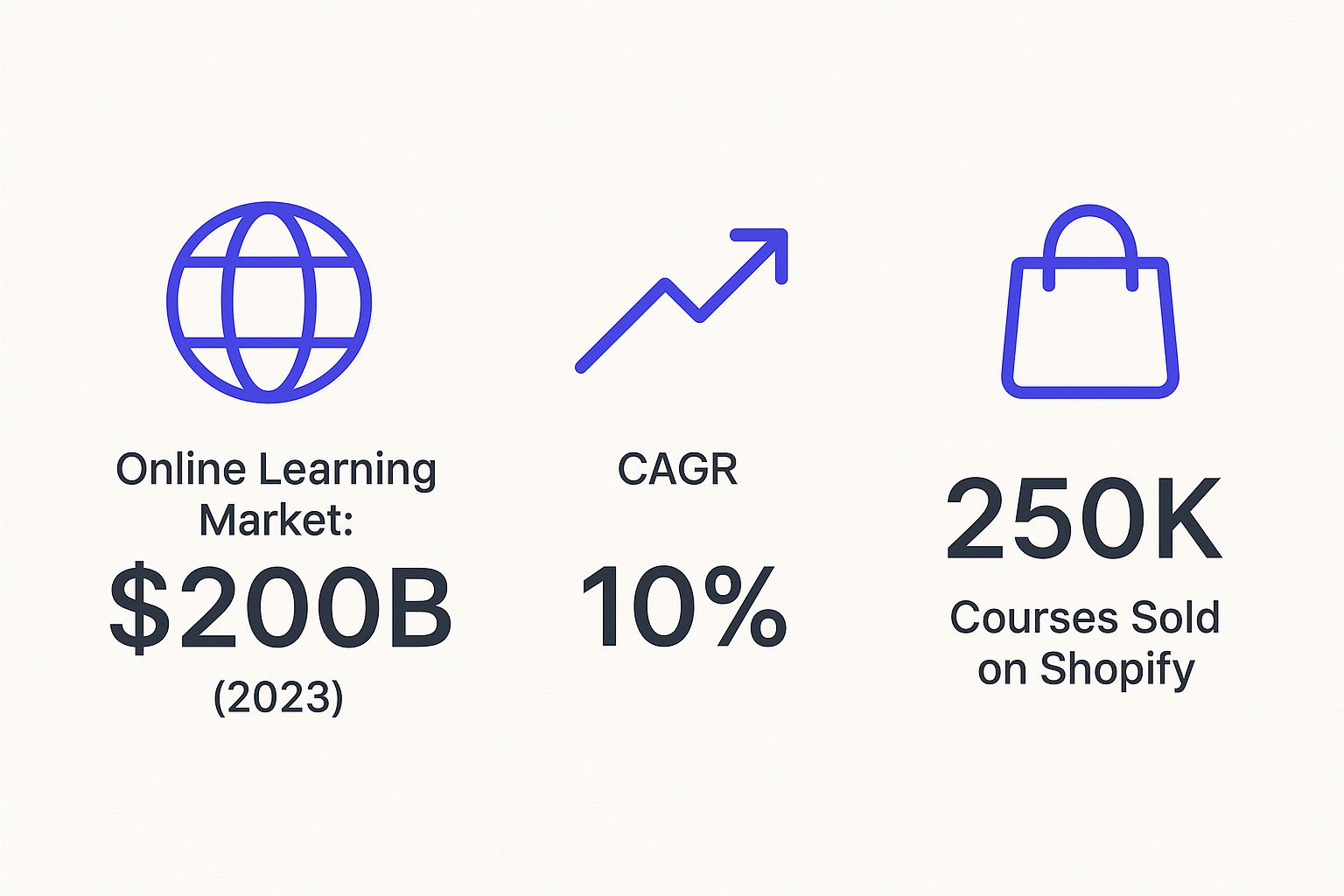Why Shopify Outperforms Traditional Course Platforms
Selling online courses takes more than just compelling content; it requires a platform that fuels business growth. While purpose-built course platforms exist, Shopify offers a unique blend of e-commerce functionality and educational tools to significantly boost your chances of success. This gives you unmatched control over your brand, customer data, and the entire sales process.

The infographic above illustrates the thriving online learning market, predicted to hit $200 billion in 2023, with a 10% compound annual growth rate (CAGR). It also showcases the impressive sales of courses on Shopify, exceeding 250,000. This data points to a rapidly expanding market and a substantial opportunity for course creators using Shopify.
Ownership and Control: The Shopify Advantage
A primary reason Shopify stands out is the complete ownership it provides. Unlike platforms that restrict access to your customer data or limit branding options, Shopify puts you in control. This allows you to build direct relationships with your students, personalize their learning journeys, and foster a loyal community around your brand.
You also have complete control over pricing and sales funnels. Implement upsells, cross-sells, and bundled offers without platform limitations, maximizing revenue potential. For example, offer a foundational course on Shopify, then upsell access to a premium community forum through a Shopify app. This flexibility is often missing from traditional course platforms. You might find this helpful: How to master selling courses on Shopify.
Myth-Busting: Shopify's Capacity for Digital Products
Some believe Shopify is mainly for physical products. This is a misconception. Shopify’s robust infrastructure and app ecosystem are well-suited to handle digital products, including online courses. Using apps like Tevello, you can seamlessly integrate course delivery, student management, and community features into your Shopify store.
Shopify's growth demonstrates its effectiveness for digital entrepreneurs. Shopify's revenue increased by about 21% in 2024, reaching $2 billion in Q2 alone. Globally, Shopify stores have processed around $1 trillion in sales. This growth benefits course sellers, as Shopify continues expanding globally and simplifies payment processing through Shopify Payments, used by roughly 1.85 million merchants. Explore more on global e-commerce statistics. This proves the platform's ability to handle large sales volumes and offer a secure environment for digital transactions.
Creative Monetization and Flexibility
Shopify's open architecture enables innovative monetization strategies beyond typical course sales. Consider memberships, subscriptions, or bundled offers that combine physical products with digital courses. This flexibility, rarely found on dedicated course platforms, gives Shopify users a competitive advantage. It broadens your potential audience and generates multiple revenue streams, fostering long-term business sustainability.
Building Your Course Storefront That Converts
Transforming your Shopify store into a thriving educational hub takes more than just listing your courses. It's about creating an environment that fosters trust and encourages students to enroll. This section explores key strategies to maximize your conversion rate when selling courses on your Shopify store.
Choosing the Right Shopify Plan
Selecting the correct Shopify plan is a crucial first step. The Basic Shopify plan works well for beginners, but as your business expands, you might need to upgrade. Consider transaction fees, the number of staff accounts, and the reporting features available on each plan. The right plan is the bedrock of future growth.
Optimizing Your Theme for Educational Products
Your Shopify theme significantly impacts user experience. Choose a theme specifically designed for digital products or one easily adaptable for online courses. Themes like Debut and Minimal provide clean layouts, easy navigation, and mobile responsiveness, ensuring your courses are accessible on any device.
-
Key Theme Considerations:
- Clear course categorization
- Engaging visuals and videos
- Student testimonial integration
- Streamlined checkout process
Structuring Your Course Pages for Conversions
Treat each course page as a dedicated landing page. Clearly outline the learning outcomes and what students will achieve upon completion. Use visuals, such as curriculum outlines or preview videos, to showcase your content. Consider including screenshots of your course platform and student dashboards.
Creating Compelling Course Descriptions
Your course description is your sales pitch. Focus on the benefits students will gain, rather than simply listing the topics covered. Explain how the course solves a student's problem. Include a FAQ section or student testimonials to address any potential concerns and build confidence in purchasing.
Structuring Your Curriculum Preview
Offering a glimpse into your course structure helps potential students understand the learning journey and assess its suitability. A well-structured preview can significantly influence enrollment rates by providing tangible value upfront.
-
Effective Preview Strategies:
- Free introductory module
- Detailed curriculum outline
- Sample lesson materials

Implementing Student-Friendly Policies
Clear policies are essential for building trust. Address common concerns like refunds and course access duration. A flexible refund policy, for example, can ease purchase hesitation. Displaying these policies prominently reinforces your professionalism and credibility, leading to a more positive student experience.
To help you compare Shopify plans based on your needs as a course creator, we've created a comparison table:
Shopify Plan Comparison for Course Sellers
This table compares different Shopify pricing tiers and how they meet the needs of course creators at different stages of business growth
| Plan Feature | Basic | Shopify | Advanced | Best For |
|---|---|---|---|---|
| Monthly Price | $29 | $79 | $299 | |
| Transaction Fees | 2.9% + 30¢ | 2.6% + 30¢ | 2.4% + 30¢ | |
| Staff Accounts | 2 | 5 | 15 | |
| Reporting | Basic reports | Standard reports | Advanced reports | |
| Best For | New businesses with limited budgets | Growing businesses needing more features | Established businesses requiring advanced analytics |
Key takeaways from this table include the increasing features and decreasing transaction fees as you move up in plan tiers. Choosing the right plan depends on your budget and business needs.
Building a high-converting course storefront on Shopify is a multi-faceted process. By implementing these strategies, you can create an engaging platform that attracts students and fuels business growth. This approach transforms your Shopify store into a vibrant learning center, maximizing your online course potential.
Essential Apps to Transform Shopify Into a Course Powerhouse
Selling courses on Shopify opens a world of possibilities. However, choosing the right apps from the Shopify app ecosystem is crucial for a seamless student experience, protecting your content, and scaling your business. This section explores essential apps that can transform your Shopify store into a course powerhouse.
Course Delivery and Content Protection
A robust app to handle course delivery and protect your content is paramount. Think of it as the engine of your course operation. Tevello Courses & Communities integrates courses directly into your Shopify store, creating a unified experience. This eliminates the need for a separate learning platform, simplifying management and enhancing the customer journey.
For enhanced security, consider apps with download restrictions, watermarking, and access control. These features are invaluable for preventing unauthorized sharing and protecting your intellectual property.
-
Key Features to Look For:
- Drip content scheduling
- Progress tracking and quizzes
- Student discussion forums
- Content encryption
Marketing and Sales Automation
Once your course infrastructure is set, optimize marketing and sales. Email marketing apps are essential for nurturing leads, promoting courses, and student engagement. Shopify integrations allow audience segmentation based on purchase history and course enrollment, enabling targeted campaigns.
Explore apps that automate sales, like abandoned cart recovery. These tools can boost conversion rates by re-engaging potential students.
You can also enhance your courses by incorporating elements from existing training. For instance, learn how to create your own security awareness training course.
Community Building and Engagement
A thriving community around your courses can be a powerful growth driver. Community apps within Shopify facilitate student interaction, foster peer-to-peer learning, and create a sense of belonging. Integrating these platforms with your course delivery app creates a central hub for all student activity. This leads to increased student satisfaction, higher retention, and positive referrals.
Analytics and Reporting
Tracking key metrics is essential for understanding performance and improvement areas. Analytics apps integrated with Shopify provide valuable insights into course performance, student engagement, and sales data. This data helps identify areas for optimization, personalize learning, and make data-driven decisions to scale your business.
Shopify's popularity for course creators is evident. As of early 2025, Shopify hosts over 2.4 million active merchants globally, with continuous growth. On average, a Shopify store generates approximately $67,000 annually, a lucrative opportunity for course sellers. Find more detailed statistics here.
Choosing the Right App Combinations
The best app combination depends on your course type and business goals. For a subscription-based membership, a robust community app with recurring billing is essential. For one-off sales, focus on marketing automation and content protection. Experimentation and continuous optimization are key to finding the perfect fit.
The following table provides a comparison of popular Shopify course delivery apps:
Top Shopify Course Delivery Apps Comparison
Detailed comparison of the most popular Shopify apps for selling and delivering online courses
| App Name | Core Features | Price Range | Best For | User Rating (Hypothetical) |
|---|---|---|---|---|
| Tevello Courses & Communities | Integrated course delivery, community features, content protection | $29/month | Shopify store owners seeking an all-in-one solution | 5 stars |
| App 2 (Example) | Drip content, quizzes, progress tracking | $A-$B/month | Course creators focused on student engagement | 4.5 stars |
| App 3 (Example) | Video hosting, download protection, watermarking | $C-$D/month | Creators prioritizing content security | 4.2 stars |
This table is a starting point. Always explore app reviews and free trials to ensure compatibility. Building a successful Shopify course business requires a strategic approach to app selection, focusing on enhancing the student experience, protecting content, and driving growth.
Crafting a Course Sales Funnel That Actually Works
Creating a successful online course takes more than just great content. It requires a well-structured sales funnel that strategically guides potential students from initial awareness to purchasing your course. Let's explore building a funnel designed for selling courses on Shopify.
Understanding the Course Sales Funnel
A typical sales funnel for online courses involves several key stages:
-
Awareness: Potential students discover your course through marketing like social media, blog posts, or online advertising.
-
Interest: They show interest by clicking an ad, registering for a webinar, or downloading a free resource.
-
Decision: They evaluate your course, comparing it with other options and assessing its value.
-
Action: They decide to purchase and enroll.
Each stage needs specific content and strategies to encourage students to move to the next step.
Creating Lead Magnets That Convert
Lead magnets are essential for capturing interest. These could include free mini-courses, downloadable worksheets, checklists, or exclusive webinar access. The key is to offer valuable content related to your paid course. This showcases your expertise and gives potential students a preview of what they can expect. For example, if your course is about "Shopify Store Design," a checklist like "10 Essential Elements of a High-Converting Shopify Store" would be an effective lead magnet. This naturally leads into the paid course, where students explore each element in detail.
Email Sequences That Address Hesitations
Once you've captured leads, nurture them with targeted email sequences. Address common hesitations or objections. For example, if time commitment is a concern, highlight the course's flexible, self-paced design. Include student testimonials and success stories to build trust and credibility.
Tiered Course Offerings and Upsells
Offer tiered courses to accommodate different budgets and learning needs. This could involve a basic course version, a premium version with bonus resources and support, or a VIP package with personalized coaching. This strategy can increase your average order value while offering more choices. You might be interested in: How to boost your digital business selling courses on Shopify.

Copywriting Techniques That Convert
Use compelling copy throughout your sales funnel. Focus on the benefits students will gain, not just the course features. Use strong calls to action and create a sense of urgency without being manipulative. Instead of "Enroll Now," try "Transform Your Shopify Store Today - Enroll Now."
Strategic Upsells and Cross-Sells
Use strategic upsells and cross-sells to maximize revenue. After a student buys a "Shopify Product Photography" course, offer an upsell to an "Advanced Shopify Marketing" course. Explore curated lists of Shopify Subscription Apps to help maximize recurring revenue.
Measuring and Optimizing Your Funnel
Continuously track key metrics like conversion rates at each stage. Identify areas for improvement and experiment. If your webinar conversion rate is low, test different formats or offer additional incentives for attendees.
By using these strategies, you can build a course sales funnel that effectively converts potential students into paying customers, creating a thriving online course business on Shopify.
Marketing Your Courses Beyond the Basics
Selling courses on Shopify requires a targeted marketing approach that goes beyond typical e-commerce strategies. It's about connecting with students eager to learn and fostering a community around your educational content. This involves identifying where your ideal students spend their time online and crafting a message that speaks directly to their learning aspirations.
Content Marketing That Establishes Expertise
Creating valuable, free content related to your course topics establishes you as a knowledgeable resource and attracts potential students. This could include blog posts, articles, videos, or even free mini-courses hosted on your Shopify site. For example, if you offer a course on "Shopify Store SEO," a blog series on "Optimizing Product Descriptions for Search Engines" could draw in your target audience. This content naturally leads into your paid course, presenting it as the logical next step in their learning journey.
Social Media Strategies for Course Creators
Different social media platforms offer unique advantages for selling courses. Choosing the right platform depends on your target audience and subject matter. Visual platforms like Instagram and Pinterest work well for visually-oriented courses like photography or design. Platforms like LinkedIn and Twitter are often more effective for professional development or business-related courses. Engaging with relevant communities and hashtags can also significantly broaden your reach.
Email Marketing for Course Sales
Building an email list is essential for nurturing leads and promoting your courses. Offer a valuable lead magnet, such as a free checklist or webinar, in exchange for email addresses. Then, use targeted email sequences to educate potential students about your courses, address any concerns, and showcase student success stories. This builds trust and encourages enrollment.
Strategic Partnerships and Cross-Promotions
Partnering with complementary businesses or influencers in your niche can significantly expand your audience. For example, if you sell a course on "Email Marketing for Shopify," partnering with a Shopify theme developer could benefit both of you. This allows you to reach new audiences and gain credibility through association. Consider offering affiliate programs to encourage partners to promote your courses.
Leveraging Peak Shopping Seasons for Course Promotions
Shopify's ability to handle high sales volume makes it an ideal platform for capitalizing on peak shopping seasons. Consider offering special discounts or promotions during periods like Black Friday and Cyber Monday. This takes advantage of increased consumer spending during these times. For example, during Black Friday and Cyber Monday in 2024, Shopify-powered brands achieved a record $11.5 billion in global sales, with over 76 million consumers making purchases. Find more detailed statistics here: Discover more insights about Shopify sales statistics. This surge in traffic and sales provides a valuable opportunity for course creators to increase revenue.
Building a Promotion Calendar Aligned With Learning Decisions
People are often more inclined to invest in learning during certain times of the year, such as the beginning of the year or after a major holiday. Create a promotion calendar aligned with these periods to maximize your marketing efforts and improve your conversion rates.
Creating Urgency and Scarcity Ethically
While creating a sense of urgency can be effective, avoid manipulative tactics. Instead, focus on limited-time offers or bonuses that provide genuine value. For example, offer a bonus Q&A session with you for students who enroll within a specific timeframe. This encourages early enrollment without resorting to high-pressure sales tactics.
By implementing these strategies, you can move beyond basic marketing and develop a comprehensive approach that attracts engaged students, builds a thriving community, and drives consistent course sales on Shopify. This approach helps position your brand as a leader in your educational niche.
Scaling Your Course Business for Sustainable Growth
Launching your online course on Shopify is a big step, but it's just the beginning. Turning your course into a thriving business requires a strategic approach to scaling. Let's explore some proven methods successful course sellers use to achieve sustainable growth.
Increasing Lifetime Customer Value
Think about maximizing the value of each student beyond their initial purchase. This means nurturing relationships and providing ongoing value to encourage repeat business and positive referrals.
-
Strategic Course Bundling: Package related courses together at a discounted price compared to buying them individually. This increases your average order value and gives students a comprehensive learning path. For example, combine courses on "Shopify Store Setup" and "Shopify Marketing" into a "Complete Shopify Success Package."
-
Tiered Membership Programs: Offer different membership levels with varying access to your courses, resources, and community. This creates recurring revenue and caters to different student budgets and learning goals.
Leveraging Automation for Personalized Learning
As your student base expands, automation becomes crucial for providing personalized learning without increasing your workload.
-
Automated Email Sequences: Use triggered emails based on student progress to offer personalized support, extra resources, or reminders about upcoming live sessions. This keeps students engaged and boosts completion rates.
-
Targeted Content Delivery: Automate the delivery of specific content or resources based on a student's learning path or interests. This personalized approach enhances student satisfaction.
Expanding Your Reach and Building Community
Strategic expansion and community building are key to sustained growth when selling courses on Shopify.
-
Internationalization: Adapt your courses for different languages and cultures to reach global markets. Shopify's multilingual features and international payment gateways can simplify this process.
-
Community Building: Create a thriving online community where students can connect, share their experiences, and support one another. This fosters a sense of belonging and encourages long-term engagement. Check out this guide on How to master pricing for your online courses.
Strategic Partnerships for Accelerated Growth
Collaborations can significantly expand your reach and credibility. Look for influencers or businesses in your niche and explore joint ventures or cross-promotions. This can introduce your courses to a new audience and position your brand as a leader in your field.
Balancing Scale with Quality and Student Satisfaction
While scaling is important, maintaining high quality and student satisfaction is paramount. Actively seek student feedback and use it to continuously improve your courses, resources, and support. Regularly update your content, respond to student questions promptly, and foster a positive learning environment for long-term success.

Scaling your course business on Shopify is more than just increasing sales; it's about building a sustainable ecosystem that supports student success and cultivates a thriving community around your brand. By implementing these strategies, you can transform your course launch into a flourishing educational enterprise. This approach emphasizes building strong relationships with students and providing ongoing value, which ultimately drives sustainable growth.
Data-Driven Course Optimization: Measuring What Matters
Transforming your Shopify course business into a success requires more than just great content. It demands understanding what truly engages students and drives sales. This means looking beyond vanity metrics like social media followers and focusing on data that reflects business health and student success. This section explores how to measure and optimize the metrics that truly matter when selling courses on Shopify.
Key Metrics for Course Success
Successful course creators track several key performance indicators (KPIs), from acquisition costs to completion rates and student satisfaction. Understanding these metrics helps identify areas for improvement and optimize your sales process.
-
Acquisition Cost: How much does it cost to acquire a new student? This metric helps evaluate your marketing effectiveness. For example, if your acquisition cost exceeds your course price, you need to re-evaluate your marketing strategy.
-
Conversion Rate: What percentage of course page visitors enroll? A low conversion rate might signal problems with your course page design, pricing, or marketing message.
-
Completion Rate: How many students finish your course? A low completion rate could suggest issues with course content, difficulty, or student engagement.
-
Student Satisfaction: How satisfied are students with their learning experience? Measure this through surveys, feedback forms, and reviews. High student satisfaction generates positive word-of-mouth referrals and repeat business.
Gathering Actionable Feedback and Identifying Areas for Improvement
Gathering feedback is about more than just testimonials; it's about pinpointing areas for improvement.
-
Surveys and Feedback Forms: Use surveys throughout the course to gather feedback on specific modules or lessons. Include open-ended questions for detailed student insights.
-
Student Forums and Communities: Create a space for students to discuss the course and share experiences. This provides valuable insights into what works and what doesn't. Tevello offers excellent community features for Shopify stores, fostering these interactions and collecting feedback directly within your platform.
Optimizing Your Sales Process Based on Data
Use the data you collect to inform your sales process optimization.
-
A/B Testing: Test different course page versions, such as varying headlines, calls to action, or pricing. This helps determine what resonates with your target audience.
-
Sales Funnel Analysis: Track students' progress through your sales funnel, from initial awareness to enrollment. Identify bottlenecks or drop-off points and adjust your strategy accordingly.
Building Effective Dashboards and Systems for Regular Review
Organize your data using dashboards that highlight areas for improvement.
-
Shopify Analytics: Use Shopify's built-in analytics to monitor sales, traffic, and conversion rates. Integrate this data with your course platform metrics for a holistic view of your business performance.
-
Custom Dashboards: Use tools like Google Data Studio or other reporting software to create custom dashboards visualizing key metrics. This lets you track progress and quickly identify areas needing attention.
Establish regular review cycles to monitor performance and make data-driven adjustments. This could be a weekly review of key metrics or a monthly deep-dive into student feedback. Systematic reviews ensure you're consistently optimizing your course for both student and business outcomes.
By adopting a data-driven approach, you can continually refine your courses, improve the student experience, and maximize your Shopify revenue potential. This involves a commitment to ongoing measurement, analysis, and optimization, treating your course business as a dynamic, evolving entity based on data insights.
Ready to transform your Shopify store into a thriving educational hub? Discover the power of Tevello today!




